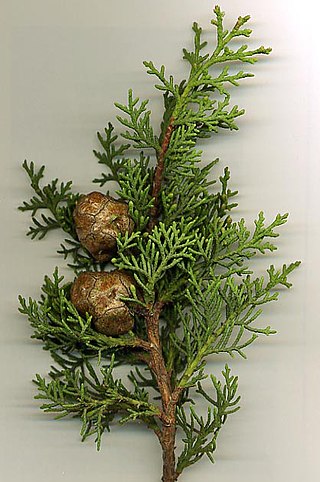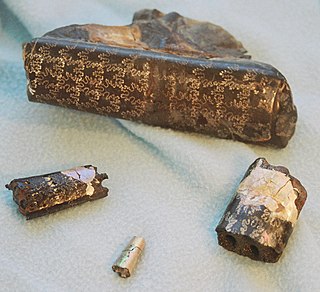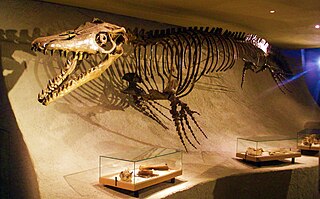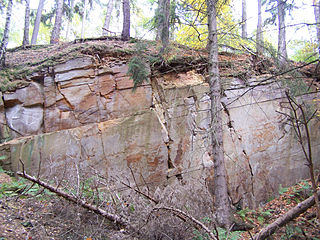
Cupressaceae is a conifer family, the cypress, with worldwide distribution. The family includes 27–30 genera, which include the junipers and redwoods, with about 130–140 species in total. They are monoecious, subdioecious or (rarely) dioecious trees and shrubs up to 116 m (381 ft) tall. The bark of mature trees is commonly orange- to red-brown and of stringy texture, often flaking or peeling in vertical strips, but smooth, scaly or hard and square-cracked in some species.

Baculites is an extinct genus of heteromorph ammonite cephalopods with almost straight shells. The genus, which lived worldwide throughout most of the Late Cretaceous, and which briefly survived the K-Pg mass extinction event, was named by Lamarck in 1799.

Mosasaurus is the type genus of the mosasaurs, an extinct group of aquatic squamate reptiles. It lived from about 82 to 66 million years ago during the Campanian and Maastrichtian stages of the Late Cretaceous. The genus was one of the first Mesozoic marine reptiles known to science—the first fossils of Mosasaurus were found as skulls in a chalk quarry near the Dutch city of Maastricht in the late 18th century, and were initially thought to be crocodiles or whales. One skull discovered around 1780 was famously nicknamed the "great animal of Maastricht". In 1808, naturalist Georges Cuvier concluded that it belonged to a giant marine lizard with similarities to monitor lizards but otherwise unlike any known living animal. This concept was revolutionary at the time and helped support the then-developing ideas of extinction. Cuvier did not designate a scientific name for the animal; this was done by William Daniel Conybeare in 1822 when he named it Mosasaurus in reference to its origin in fossil deposits near the Meuse River. The exact affinities of Mosasaurus as a squamate remain controversial, and scientists continue to debate whether its closest living relatives are monitor lizards or snakes.

The Maastrichtian is, in the ICS geologic timescale, the latest age of the Late Cretaceous Epoch or Upper Cretaceous Series, the Cretaceous Period or System, and of the Mesozoic Era or Erathem. It spanned the interval from 72.1 to 66 million years ago. The Maastrichtian was preceded by the Campanian and succeeded by the Danian.

The Hell Creek Formation is an intensively studied division of mostly Upper Cretaceous and some lower Paleocene rocks in North America, named for exposures studied along Hell Creek, near Jordan, Montana. The formation stretches over portions of Montana, North Dakota, South Dakota, and Wyoming. In Montana, the Hell Creek Formation overlies the Fox Hills Formation. The site of Pompeys Pillar National Monument is a small isolated section of the Hell Creek Formation. In 1966, the Hell Creek Fossil Area was designated as a National Natural Landmark by the National Park Service.

Betasuchus is a genus of theropod dinosaur which lived during the Late Cretaceous Period. Betasuchus is, besides Orthomerus, the only dinosaur genus named from remains found in the Netherlands and the only non-avian theropod found in the Maastrichtian Beds.

Plioplatecarpus is a genus of mosasaur lizard. Like all mosasaurs, it lived in the late Cretaceous period, about 73-68 million years ago.

The Maastricht Formation, named after the city of Maastricht in the Netherlands, is a geological formation in the Netherlands and Belgium whose strata date back to the Late Cretaceous, within 500,000 years of the Cretaceous–Paleogene boundary, now dated at 66 million years ago. The formation is part of the Chalk Group and is between 30 and 90 metres thick. It crops out in southern parts of Dutch and Belgian Limburg and adjacent areas in Germany. It can be found in the subsurface of northern Belgium and southeastern Netherlands, especially in the Campine Basin and Roer Valley Graben. Dinosaur remains are among the fossils that have been recovered from the formation.
This is an overview of the fossil flora and fauna of the Maastrichtian-Danian Hell Creek Formation.
Cunninghamites elegans is an extinct conifer species in the family Cupressaceae and the genus Cunninghamites.

Agathoxylon is a form genus of fossil wood, including massive tree trunks. Although identified from the late Palaeozoic to the end of the Mesozoic, Agathoxylon is common from the Carboniferous to Triassic. Agathoxylon represents the wood of multiple conifer groups, including both Araucariaceae and Cheirolepidiaceae, with late Paleozoic and Triassic forms possibly representing other conifers or other seed plant groups like "pteridosperms".

Nilssonia is a genus of fossil foliage traditionally assigned to the Cycadophyta either in Cycadales or their own order Nilssoniales, though the relationships of this genus with the Cycadales have been put into question on chemical grounds.

Zamites is a genus of sterile foliage known from the Mesozoic of North America, Europe, India and Antarctica through the Eocene of North America. It was erected as a form taxon for leaves that superficially resembled the extant cycad Zamia, however it is now believed to belong to a similar but phylogenetically different group, the cyacadeoids (Bennettitales). The fronds are linear or lanceolate in shape, and pinnately compound, with pinnae with parallel veins and smooth margins, and symmetrical and constricted at the base where they are attached obliquely to the upper surface of the rachis. It has been interpreted as a Bennettitalean plant in the family Williamsoniaceae. It is associated with the ovulate cone Williamsonia and male cone Weltrichia.

The Exter Formation is the only formation of the Upper Keuper or Rhätsandstein, and is a geologic formation in Germany. It preserves fossils dating back to the Rhaetian of the Triassic period.

Baiera is a genus of prehistoric gymnosperms in the order Ginkgoales. It is one of the oldest fossil foliage types of Ginkgoales, and is related to the genera Ginkgo and Ginkgoites. Fossils of Baiera are found worldwide, and have been known from the Permian to the Cretaceous.

The term Paleocene ammonites describes families or genera of Ammonoidea that may have survived the Cretaceous–Paleogene extinction event, which occurred 66.043 million years ago. Although almost all evidence indicated that ammonites did not survive past the K–Pg boundary, there is some scattered evidence that some ammonites lived for a short period of time during the Paleocene epoch, although none survived the Danian ; they were likely extinct within 500,000 years of the K-Pg extinction event, which correlates to roughly 65.5 Ma. The evidence for Paleocene ammonoids is rare and remains controversial.
This article records new taxa of fossil plants that are scheduled to be described during the year 2021, as well as other significant discoveries and events related to paleobotany that are scheduled to occur in the year 2021.

Czekanowskiales, also known as Leptostrobales, are an extinct group of seed plants. Members of the family are distinguished by persistent leaves borne on deciduous short shoots, subtended by scale-like leaves. The leaves are highly dissected. They likely grew as trees and shrubs. The main ovulate structure of Czekanowskiales, Leptostrobus, consists of bivalved seed-bearing round capsule-like structures arranged along a long axis. The fossil record of Czekanowskiales is largely confined to the Northern Hemisphere, and they inhabited warm-temperate and temperate climates under humid conditions. The oldest possible records of the group are ovulate cones from the Late Permian of Italy, but the group is primarily known from the Late Triassic onwards, and were abundant during the Jurassic and Early Cretaceous. Only a handful of species are known from the Late Cretaceous, confined to the northern Russian Far East, corresponding to the decline of other seed plant groups during the explosive radiation of flowering plants. The affinites of Czekanowskiales to other seed plants are obscure. A close relationship to the Ginkgoales has been proposed, based on similar preserved molecular signatures of fossil cuticles, with some authors placing Ginkgoales and Czekanowskiales into the broader grouping Ginkgophyta.

Eubaculites is an extinct genus of cephalopods in the family Baculitidae and each known species was initially placed within the related genus Baculites until it was placed in a separate genus in 1926.















